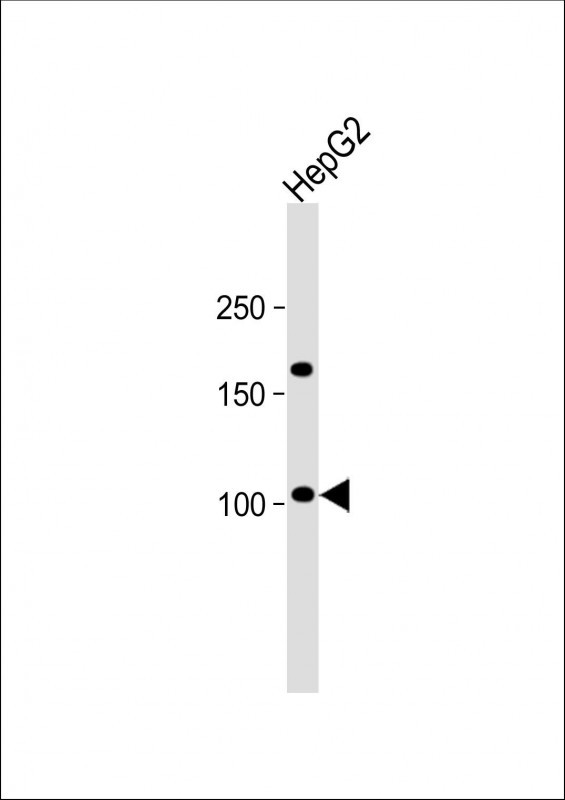NLRP12 Antibody
Affinity Purified Rabbit Polyclonal Antibody (Pab)
- 产品详情
- 实验流程
- 背景知识
Application
| WB, E |
|---|---|
| Primary Accession | P59046 |
| Reactivity | Human |
| Host | Rabbit |
| Clonality | Polyclonal |
| Isotype | Rabbit IgG |
| Calculated MW | 120173 Da |
| Gene ID | 91662 |
|---|---|
| Other Names | NACHT, LRR and PYD domains-containing protein 12, Monarch-1, PYRIN-containing APAF1-like protein 7, Regulated by nitric oxide, NLRP12, NALP12, PYPAF7, RNO |
| Target/Specificity | This NLRP12 antibody is generated from rabbits immunized with human NLRP12 recombinant protein. |
| Dilution | WB~~1:500 E~~Use at an assay dependent concentration. |
| Format | Purified polyclonal antibody supplied in PBS with 0.05% (V/V) Proclin 300. This antibody is purified through a protein A column, followed by peptide affinity purification. |
| Storage | Maintain refrigerated at 2-8°C for up to 2 weeks. For long term storage store at -20°C in small aliquots to prevent freeze-thaw cycles. |
| Precautions | NLRP12 Antibody is for research use only and not for use in diagnostic or therapeutic procedures. |
| Name | NLRP12 |
|---|---|
| Synonyms | NALP12, PYPAF7, RNO |
| Function | Plays an essential role as an potent mitigator of inflammation (PubMed:30559449). Primarily expressed in dendritic cells and macrophages, inhibits both canonical and non-canonical NF-kappa-B and ERK activation pathways (PubMed:15489334, PubMed:17947705). Functions as a negative regulator of NOD2 by targeting it to degradation via the proteasome pathway (PubMed:30559449). In turn, promotes bacterial tolerance (PubMed:30559449). Also inhibits the RIGI- mediated immune signaling against RNA viruses by reducing the E3 ubiquitin ligase TRIM25-mediated 'Lys-63'-linked RIGI activation but enhancing the E3 ubiquitin ligase RNF125-mediated 'Lys-48'-linked RIGI degradation (PubMed:30902577). Also acts as a negative regulator of inflammatory response to mitigate obesity and obesity-associated diseases in adipose tissue (By similarity). |
| Cellular Location | Cytoplasm. |
| Tissue Location | Detected only in peripheral blood leukocytes, predominantly in eosinophils and granulocytes, and at lower levels in monocytes. |
For Research Use Only. Not For Use In Diagnostic Procedures.
Provided below are standard protocols that you may find useful for product applications.
BACKGROUND
NALPs are cytoplasmic proteins that form a subfamily within the larger CATERPILLER protein family. Most short NALPs, such as NALP12, have an N-terminal pyrin (MEFV; MIM 608107) domain (PYD), followed by a NACHT domain, a NACHT-associated domain (NAD), and a C-terminal leucine-rich repeat (LRR) region. The long NALP, NALP1 (MIM 606636), also has a C-terminal extension containing a function to find domain (FIIND) and a caspase recruitment domain (CARD). NALPs are implicated in the activation of proinflammatory caspases (e.g., CASP1; MIM 147678) via their involvement in multiprotein complexes called inflammasomes.
REFERENCES
Ye,Z., Mol. Cell. Biol. 28 (5), 1841-1850 (2008)
Jeru,I., Proc. Natl. Acad. Sci. U.S.A. 105 (5), 1614-1619 (2008)
Arthur,J.C., J. Immunol. 179 (9), 6291-6296 (2007)
终于等到您。ABCEPTA(百远生物)抗体产品。
点击下方“我要评价 ”按钮提交您的反馈信息,您的反馈和评价是我们最宝贵的财富之一,
我们将在1-3个工作日内处理您的反馈信息。
如有疑问,联系:0512-88856768 tech-china@abcepta.com.























 癌症的基本特征包括细胞增殖、血管生成、迁移、凋亡逃避机制和细胞永生等。找到癌症发生过程中这些通路的关键标记物和对应的抗体用于检测至关重要。
癌症的基本特征包括细胞增殖、血管生成、迁移、凋亡逃避机制和细胞永生等。找到癌症发生过程中这些通路的关键标记物和对应的抗体用于检测至关重要。 为您推荐一个泛素化位点预测神器——泛素化分析工具,可以为您的蛋白的泛素化位点作出预测和评分。
为您推荐一个泛素化位点预测神器——泛素化分析工具,可以为您的蛋白的泛素化位点作出预测和评分。 细胞自噬受体图形绘图工具为你的蛋白的细胞受体结合位点作出预测和评分,识别结合到自噬通路中的蛋白是非常重要的,便于让我们理解自噬在正常生理、病理过程中的作用,如发育、细胞分化、神经退化性疾病、压力条件下、感染和癌症。
细胞自噬受体图形绘图工具为你的蛋白的细胞受体结合位点作出预测和评分,识别结合到自噬通路中的蛋白是非常重要的,便于让我们理解自噬在正常生理、病理过程中的作用,如发育、细胞分化、神经退化性疾病、压力条件下、感染和癌症。






